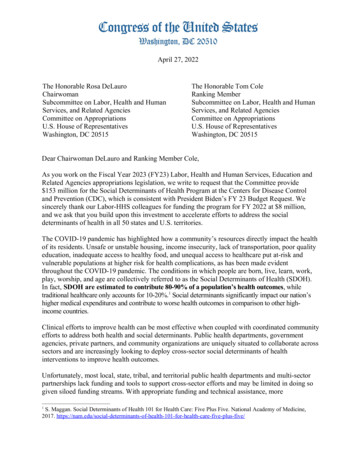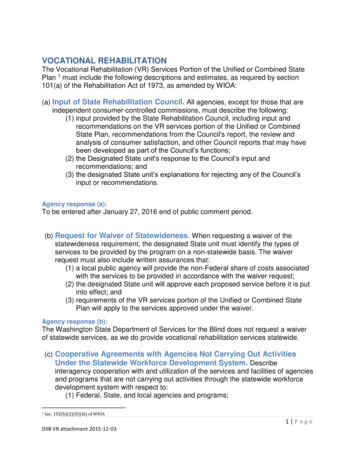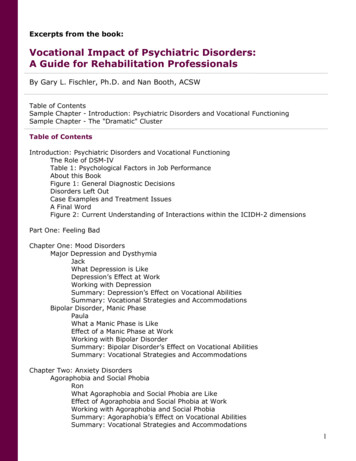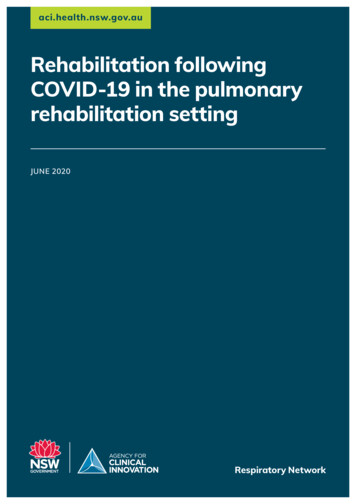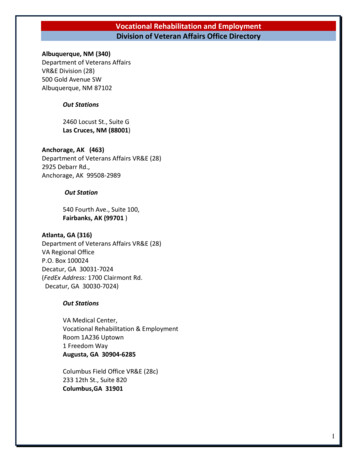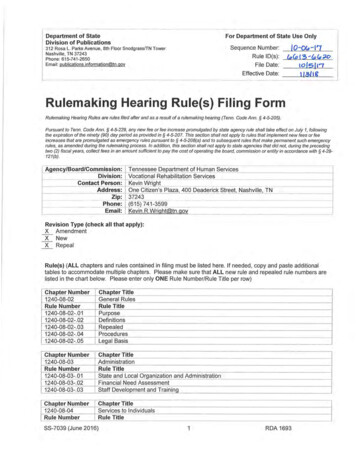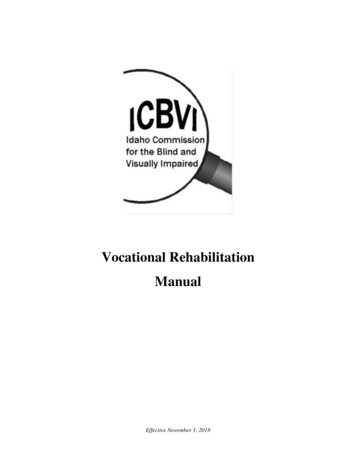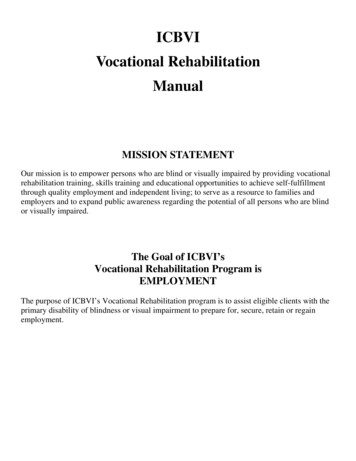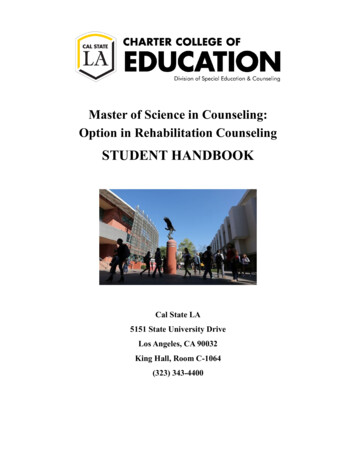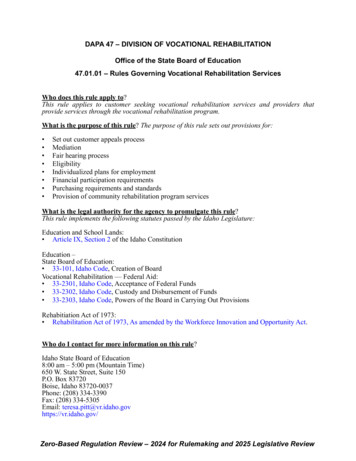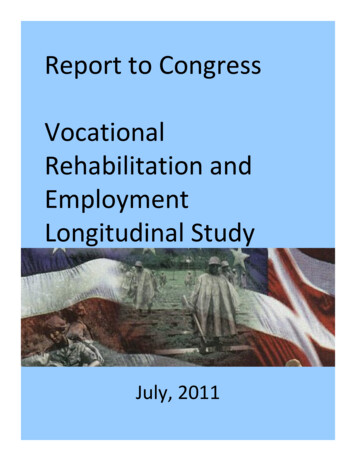
Transcription
Report to CongressVocationalRehabilitation andEmploymentLongitudinal StudyJuly, 2011
Longitudinal Study of Vocational Rehabilitation Programs2011 ReportTABLE OF CONTENTSExecutive Summary ��‐‐‐‐‐‐‐‐‐ 2Section 1:Overview Vocational Rehabilitation and Employment �‐‐‐‐‐ 5Section 1A: Services Provided by VR&E’s VetSuccess ��‐‐‐10Section 1B: Evolution of Vocational Rehabilitation for Veterans tion 1C: The VR&E Process ‐‐‐‐‐‐‐‐‐14Section 2:Introduction to the 2010 Longitudinal Study ��‐‐‐‐‐‐‐16Section 2A: Analysis of the 2010 Longitudinal Study Active Participants ‐‐‐‐‐18Section 2B: Analysis of the 2010 Longitudinal Study Discontinued Cases ‐‐‐‐34Section 2C: Analysis of the 2010 Longitudinal Study Participants WhoSuccessfully Completed their Rehabilitation �‐‐‐‐‐ 62Index of Data Points ��‐‐‐‐‐‐‐‐63Acronyms and �‐‐‐‐‐68Vocational Rehabilitation and EmploymentLongitudinal Study FY 2010Page ‐ 1
Longitudinal Study of Vocational Rehabilitation Programs2011 ReportExecutive SummaryThe Department of Veterans Affairs (VA) Vocational Rehabilitation and Employment (VR&E)program is pleased to present the first report for the fiscal year (FY) 2010 Longitudinal Studyparticipants. The Longitudinal Study provides an opportunity to increase our understandingof the disabled Veterans we serve, to recognize their needs and challenges, and to celebratetheir successes.Veterans with disabilities face multiple physical, mental, and economic effects from theirdisabilities, which may include unemployment or lower wages when employed. DisabledVeterans may struggle to maintain their role as providers within their families and/orreduced ability to perform activities of daily living. The mission of the VR&E program is toassist Veterans who have obtained a service‐connected disability to regain employment, andto enable these Veterans to participate fully in the economic and social facets of family andcommunity life.Although the first report for the FY 2010 Longitudinal Study participants is a starting pointfor comparison and does not yet allow for the level of analysis that future Longitudinal Studyreports will allow, it demonstrates some important aspects of the VR&E (Chapter 31)program.Below is a summary of major findings of the initial year of the FY 2010 Longitudinal Study.Demographics of the Veterans We Serve Women make up a growing but smaller portion ofthe U.S military population than they do of thegeneral U.S population. 1 Women make up about eight percent of the overallVeteran population but comprise about 17 percent ofthe FY 2010 Longitudinal Study participants.Gender of FY 2010 LongitudinalStudy ParticipantsAll Case StatusesFemale17%Male83% Women comprise 16 percent of the FY 2010Longitudinal Study participants who have a seriousemployment handicap.1Source: Department of Veterans Affairs, Office of the Actuary, Veteran Population Projections Model (VetPop),2007 tables 5L and 8D.Vocational Rehabilitation and EmploymentLongitudinal Study FY 2010Page ‐ 2
Longitudinal Study of Vocational Rehabilitation Programs2011 Report At the time that they separated from the military, the majority of FY 2010Longitudinal Study participants were enlisted personnel. Over 50 percent were an E4 orlower. About 75 percent of our FY 2010 Longitudinal Study participants were in serviceduring the Gulf War Era (from August 2, 1990 onward). The majority of the FY 2010 Longitudinal Study participants have a high schooldegree or a high school degree and some post high school training when they enterVR&E. Some participants also have advanced degrees in occupations they can no longerperform due to their service‐connected disabilities. Individuals are found entitled toservices because the jobs for which they are currently qualified aggravate their service‐connected disabilities and then need re‐training. Alternatively, their training may needupdating in order to be competitive in the current job market. Over 80 percent of the 10,793 participants in the study required long‐term services inorder to assist them to gain suitable employment.Rehabilitation Track of FY 2010 Longitudinal Study ParticipantsAll Case Statuses0.2%80.1%7.9%0.6%5.6%5.6%Not SelectedRapid Access to EmploymentRe-EmploymentIndependent LivingEmployment Through Long Term ServicesSelf EmploymentVocational Rehabilitation and EmploymentLongitudinal Study FY 2010Page ‐ 3
Longitudinal Study of Vocational Rehabilitation Programs2011 ReportVeteran SuccessesWhile the majority of the FY 2010 Longitudinal Study participants require long‐term servicesto assist them in reaching their rehabilitation goals, a small percentage (1.7 percent) bothstarted and completed their plan of services during 2010.Participants who completed their rehabilitation plans are beginning on their new careertracks. These careers are in jobs that are suitable for the limitations of their service‐connected disabilities.The majority of the participants who start VR&E services are unemployed. Nationally, FY2010 Longitudinal Study participants averaged an increase of over 600 percent from startingto ending salaries. Women experienced a greater salary change than men, due in part totheir lower starting salaries; however, female FY 2010 Longitudinal Study participants hadthe highest post‐rehabilitation average annual salary at 37,666.National Pre and Post Rehabilitation Annual Salaries for FY 2010 Longitudinal StudyParticipants Who Completed Their Rehabilitation Program2011 ReportFY 2010 Longitudinal Study Participants With ASerious Employment HandicapAll FY 2010 Longitudinal Study ParticipantsPre RehabPost RehabSalarySalary 5,320.00 36,170.00Independent Living ParticipantsTotal RehabilitationsPercentChange632%Number ofParticipants14733180Pre RehabPost RehabSalarySalary 5,658.00 33,578.00Independent Living ParticipantsTotal RehabilitationsPercentChange593%Number ofParticipants8233115National Pre and Post Rehabilitation Annual Salaries by Gender for FY 2010 Longitudinal StudyParticipants Who Completed Their Rehabilitation Program2011 ReportAll FY 2010 Longitudinal Study ParticipantsGenderMalesFemalesPre RehabPost RehabSalarySalary 6,073.00 34,112.00Independent Living Participants 3,480.00 37,666.00Independent Living ParticipantsTotal RehabilitationsPercentChange462%982%Number ofParticipants12731202180FY 2010 Longitudinal Study Participants With ASerious Employment HandicapPre RehabPost RehabSalarySalary 6,086.00 33,884.00Independent Living Participants 2,954.00 32,462.00Independent Living ParticipantsTotal RehabilitationsVocational Rehabilitation and EmploymentLongitudinal Study FY 2010Page ‐ 4PercentChange457%999%Number ofParticipants6931132115
Longitudinal Study of Vocational Rehabilitation Programs2011 ReportSection 1: Overview of Vocational Rehabilitation & EmploymentThe FY 2010 Longitudinal Study population is a subset of the total VR&E population. It isimportant to view the 2010 study population in context of the entire VR&E program.Section 1:Overview of VR&EProvides a brief overview of the VR&E program and outcomes.Section 1A:Services Provided by VR&E’s VetSuccess ProgramProvides a brief overview of the services provided to Veterans.Section 1B:Evolution of Vocational Rehabilitation for VeteransProvides a brief history of the VR&E VetSuccess Program.Section 1C:The Chapter 31 ProcessProvides detailed examples of services Veterans can receive from VR&E.VetSuccessVR&E operates its program under the banner of VetSuccess. VetSuccess helps Veteransmake career decisions, prepare for careers, and succeed in suitable jobs. VetSuccessprovides guidance and advocacy while Veterans complete training and college programs andthroughout the job‐placement process. VetSuccess assists Veterans to start their ownbusinesses, and provides services to help Veterans live as independently as possible in theirhomes and communities.VR&E continues to develop and expand methods to assist Servicemembers and Veterans inobtaining and maintaining suitable employment, with a focus on outreach and early entryinto VR&E services during transition from active duty. Expanded outreach and earlyintervention for Servicemembers and Veterans have resulted in increased program emphasison briefings for active duty Servicemembers and National Guard and Reserve Members. Wealso expanded the scope of our program to serve Veterans in VA education programs,including the Post‐9/11 GI Bill, through our “VetSuccess on Campus” program, whichprovides outreach and transition services to the general Veteran population during theirtransition from military to college life.The VetSuccess on Campus program assigns a VA Vocational Rehabilitation Counselor toeach participating campus to provide vocational testing and career, academic, andreadjustment counseling services. A VA Vet Center Outreach Coordinator is co‐located oncampus, to provide peer‐to‐peer counseling and referral services. VetSuccess counselorsensure that Veterans receive the support and assistance needed to succeed in educationaland employment goals.Vocational Rehabilitation and EmploymentLongitudinal Study FY 2010Page ‐ 5
Longitudinal Study of Vocational Rehabilitation Programs2011 ReportVR&E continues work to provide more and/or enhanced employment tools by leveragingtechnology. This includes projects such as a remote counseling pilot, which benefits themost severely disabled and rural Veterans; and expansion of the functionality of ourVeteran‐facing website, VetSuccess.gov.VetSuccess.gov is a virtual resource center for Veterans seeking jobs and for employerswishing to hire Veterans. Veterans can now browse multiple job banks for job listings, postresumes, and apply for jobs online. Veterans may also apply for the VR&E program andother VA benefits through this site. Expanded content under development includesresources for transitioning Veterans, Veterans in college, Veterans starting their ownbusinesses, and Veterans seeking maximum independence in daily living.VR&E FY 2010 ParticipantsAt the close of FY 2010, VR&E had 117,130 Veterans active in any stage of the vocationalrehabilitation process, including: Applicant, Evaluation and Planning, Extended Evaluation,Independent Living, Job Ready Status, Rehabilitation to Employment, and Interrupted.During FY 2010, there were 10,038 Veterans who successfully completed their rehabilitationplan.Quick Reference GuideVeterans receiving Vocational Rehabilitation and Employment (VR&E) benefits at theTotal117,130Male Veterans participating in the VR&E programFemale Veterans participating in the VR&E program94,99522,135Total Number of Veterans Rehabilitated in FY 2010Disabled Veterans with a serious employment handicaps who weresuccessfully rehabilitatedDisabled Veterans with an employment handicap who weresuccessfully rehabilitated10,038Vocational Rehabilitation and EmploymentLongitudinal Study FY 2010Page ‐ 65,8254,213
Longitudinal Study of Vocational Rehabilitation Programs2011 ReportVR&E FY 2010 Program FactsVeterans Participating in aVocational TrainingProgramDuring Fiscal Year l/Technical3,174Graduate School3,093College, NonDegree1,481Extended Eval/IndependentLiving972Paid On-the-JobTraining166Non-Paid WorkExperience inthe Government314Non-Paid On-theJob Training124Apprenticeship91Improvement ofRehab Potential76High School8Farm Co-op19TotalAll Veterans who apply for VR&E services are offered anindividualized assessment of their interests, skills and disabilityneeds. Upon completion of the individualized evaluationprocess, Veterans enter a rehabilitation program to becomejob ready in their selected vocational choice or to achieve themaximum ability to live independently in the community.The length of time that Veterans remain in a rehabilitationprogram varies according to the Veteran’s individualcircumstances. The average time spent in the program isapproximately two and one‐half years.Of those Veterans participating in a plan of services, mostfollow the long‐term services employment track and receiveservices that include career counseling, case management,employment planning, training or education, VHA‐sponsoredmedical or dental care, job‐placement assistance, and othersupportive services.Over ninety percent of the Veterans who are in the long‐termservices track participate in training at an institution of higherlearning.More than half of the Veterans participating in VR&E have aserious employment handicap, which means there is significantimpairment of a Veteran’s ability to prepare for, pursue, orretain employment consistent with the Veteran’s abilities,aptitudes, and interests. These Veterans receive additionalsupportive services, which may include extensions ofentitlement, adaptive equipment, job coaching, andindependent living services.60,522Source: VR&E Program ManagementReports – Snapshot of VR&EParticipants at the end of Fiscal Year2010.Vocational Rehabilitation and EmploymentLongitudinal Study FY 2010Page ‐ 7
Longitudinal Study of Vocational Rehabilitation Programs2011 ReportVR&E FY 2010 RehabilitationsThe average annual wage of disabled Veterans who enteredthe VR&E program in 2010 was 7,178.This places them approximately 33 percent below the 2010poverty guideline. Conversely, the average annual wage forVeterans successfully completing the VR&E program in 2010was 34,711, or 220 percent above the 2010 poverty guidelineof 10,830 for a single person.Rehabilitation Outcomes BYEmploymentHandicap in FY 201012,00010,0008,000Veterans who complete their training and begin a job searchare placed in Job Ready Status. While in Job Ready Status, theVeteran works with a counselor to: Obtain a suitable job,Become stable in the job, andReceive follow‐up support for a minimum of 60 daysonce the job is stable.42%6,0004,00058%2,0000In special circumstances, such as to meet the needs of a severedisability or to monitor stability of a Veteran who has becomeself employed, job‐ready support can be provided for up to 18months.The average number of days a Veteran is in Job Ready status is198 (meaning the time it took for them to obtain employment,become stable in their job and be followed for a minimum of60 days).Em ploym ent HandicapSerious Em ploym entHandicapTypes of Rehabilitation Outcomesin FY 2010120001000026%Over 74 percent of the successful closures in 2010 wereVeterans who obtained and maintained employment. Theremaining 26 percent were Veterans who participated in theVR&E Independent Living program and are not currently ableto obtain employment, but achieved their goals of increasingtheir independence in daily living.8000Veterans who have a Serious Employment Handicap represent58 percent of the successfully rehabilitated closures in FY 2010.20006000400074%01Independent LivingEm ploym entVocational Rehabilitation and EmploymentLongitudinal Study FY 2010Page ‐ 8
CareerOutcomesfor VocationalRehabilitationand EmploymentLongitudinalStudy of VocationalRehabilitationPrograms2011 ReportFY 2010FY2010 Career CategoryNATIONAL AVERAGESProfessional, Technical, and ManagerialClericalSalesServiceAgricultural, Fishery and ForestryProcessing (Butcher, Meat Processor, etc.)Machine TradesBench WorkStructural (Building 5Avg. AnnualWages Prior toVR&EProgramEntrance 7,178.41 9,407.64 5,768.36 5,267.06 5,867.12 7,952.40 2,030.77 6,903.35 8,998.64 7,710.04Career Outcomes, FY20108%3%79%4%6%Professional, Technical, and ManagerialClericalServiceMachine TradesOther (below 2% each category)Rehabilitated VR&E Participants By Period Of ServiceFY 2010977411,066697,850332Gulf War EraPost - Vietnam EraWorld War IIKorean ConflictVietnam EraPost - Korean ConflictPost World War II EraVocational Rehabilitation and EmploymentLongitudinal Study FY 2010Page ‐ 9Avg. Annual Wagesat Rehabilitation 34,711.82 38,734.96 30,582.85 28,418.83 29,507.85 22,720.00 29,171.08 30,314.94 30,320.45 34,547.47
Longitudinal Study of Vocational Rehabilitation Programs2011 ReportServices Provided by VR&E’s VetSuccess ProgramVR&E is one of five business lines within the Veterans Benefits Administration (VBA) thatprovides benefits and services to Veterans and Servicemembers. VR&E’s VetSuccessprogram primarily delivers rehabilitation services to assist Veterans with service‐connecteddisabilities to prepare for, obtain and retain careers in the civilian workforce. For thoseVeterans for whom employment is not currently an option, the program provides a widerange of services in the Independent Living program. VR&E also provides benefits andservices to eligible family members.VR&E administers four benefits programs authorized under Title 38U.S.C. Chapter 31 (Training and Rehabilitation for Veterans withService‐Connected Disabilities); Chapter 36 (Educational Vocational Counseling); Chapter 18 (Vocational Training for Vietnam Veterans’Children with Spina Bifida); and Chapter 35 (Dependents Educational Assistance).VR&E administers these four programs through a decentralizedservice‐delivery network composed of 57 VBA regional offices andover 100 out‐based offices. This network is staffed with a VR&Eworkforce of over 1,000 professional vocational rehabilitationcounselors and support staff along with a complement of contractcounselors and other professionals.VR&E’sVetSuccessprogramprimarily deliversrehabilitationservices to assistVeterans withservice‐connecteddisabilities toprepare for,obtain and retaincareers in thecivilianworkforce.Three key features distinguish the VR&E service‐delivery strategyfrom the service‐delivery strategies of VBA’s other lines of business.1. VR&E provides individualized services that require regular face‐to‐face interactionswith Veterans to deliver the benefits and services, in contrast to VBA’s other lines ofbusiness that focus primarily on claims processing.2. The cycle of an active VR&E case may extend over four or more years. A multi‐yeartimeframe is necessary to provide adequate re‐training for Veterans so that they canobtain employment that accommodates their disabilities.3. VR&E has the largest out‐based network of service delivery points of any VBAbusiness line.The VR&E VetSuccess program workload is predominately driven by two factors: the numberof Veterans applying for rehabilitation and training benefits and services (Chapter 31, Title38); and the number of Veterans who enter into the development and implementation of arehabilitation plan.Vocational Rehabilitation and EmploymentLongitudinal Study FY 2010Page ‐ 10
Longitudinal Study of Vocational Rehabilitation Programs2011 ReportOnce a Veteran applies and is determined eligible for services, the Veteran meets with aVR&E Counselor to complete an entitlement determination.If the Veteran orServicemember is not entitled, the counselor will assist with any necessary referrals forother services. After the Veteran or Servicemember is determined entitled to vocationalrehabilitation services, the Veteran begins assessment and evaluation activities. Based uponthe results of these evaluations, the Veteran and counselor will develop a rehabilitation planfrom one of five tracks of services.Five Tracks of Services:1. Re‐Employment: For those Veterans who have recently exited the military, areinterested in returning to their previous employer, and for whom their previous job issuitable for their disability, VR&E provides services such as adjustment counseling,disability information and accommodation, and support contacting their previousemployer.2. Rapid Access to Employment: For those Veterans who possess the skills and abilitiesto obtain suitable employment, VR&E provides short‐term training, counseling andintensive job‐placement supports.3. Self‐Employment: For those Veterans interested in starting their own business,supports in this track can include training and business start‐up supports.4. Employment through Long‐Term Services: The majority of disabled Veterans requirelong‐term support, typically to include college, on‐the‐job training, or anapprenticeship program. The length of time Veterans are served under VR&E variesaccording to their disability needs, occupational choice, and pre‐existing skills andabilities.5. Independent Living: For those Veterans for whom employment is not currentlyfeasible, independent living services assist them with living more independently intheir homes and communities.The Rehabilitation Plan: Lists the services that will be provided; Identifies the steps the Veteran will take; and Identifies milestones of progress and estimates timeframes for their completion.The rehabilitation plan can be re‐developed based on new needs or circumstances identifiedby the Veteran and counselor. The counselor and Veteran continue to meet for supportiveservices throughout all steps of the rehabilitation plan. Monitoring and support continue aslong as the Veteran is a VR&E participant.Once Veterans complete the steps of the rehabilitation plan, they meet with their Counselorto assess their readiness to enter employment. When Veterans are determined to be job‐Vocational Rehabilitation and EmploymentLongitudinal Study FY 2010Page ‐ 11
Longitudinal Study of Vocational Rehabilitation Programs2011 Reportready, they develop a job‐ready plan of services. Job‐ready services include assistanceidentifying employers, preparing for interviews, developing a resume, and conducting a jobsearch.The VR&E counselor then assists these Veterans with obtaining employment; ensures thatthe employment is stable; and once stable employment is reached, provides follow‐upservices for at least 60 days before closing the case as rehabilitated.Evolution of Vocational Rehabilitation for VeteransVocational rehabilitation began as a government service to war‐injured Veterans anddisabled citizens during the World War I era. In 1917, the War Risk Insurance Act of 1914was amended to provide rehabilitation and vocational training for Veterans withdismemberment injuries, injuries to their sight or hearing, and other injuries resulting inpermanent disability. Although the legislative history of VA’s vocational rehabilitationprogram has not been as dynamic as the compensation and pension programs or perhapsVBA’s other lines of business, the basis for the program has changed substantively since itwas first created. At the same time, the organization that administers this program withinVBA has also evolved. The following legislative history of the VR&E in responseprogram provides a context for understanding many of the issuesto Veterans’that impact reform.Legislative HistorySince the original legislation establishing what is now the VR&Eprogram, there have been several pieces of legislation that made theprogram what it is today. 1918 – Public Law 65‐178 expanded eligibility for otherdisabilities that were vocationally “handicapping.” 1943 – Public Law 78‐16 established the vocationalneeds, theVR&EVetSuccessprogram haschangedsubstantivelysince it wasfirst created.rehabilitation program for Veterans of World War II. 1962 – Public Law 87‐815 authorized vocational rehabilitation benefits for Veteranswho served during peacetime, but created more restrictive eligibility criteria for thosewho served in peacetime as compared to those who served in World War II or theKorean Conflict. Veterans with 10 percent and 20 percent service‐connecteddisabilities were not eligible for vocational rehabilitation. 1974 – Public Law 93‐508 relaxed eligibility and entitlement provisions of the programto allow 10 and 20 percent service‐disabled Veterans to receive vocationalrehabilitation benefits.Vocational Rehabilitation and EmploymentLongitudinal Study FY 2010Page ‐ 12
Longitudinal Study of Vocational Rehabilitation Programs2011 Report 1977 – Public Law 95‐202 directed VA to engage in greater efforts to encourageVeterans to use vocational rehabilitation and counseling services. This change and thesubsequent legislative change in 1980 were the result of Congressional scrutiny of theprogram. 1980 ‐ Public Law 96‐466 changed the purpose of the program to include independentliving and services necessary to ensure that Veterans with service‐connecteddisabilities not only obtained but maintained suitable employment. This legislationalso changed the success criteria for the program to achievement of suitableemployment and provided for intensive outreach and comprehensive, individualizedplans for rehabilitation services. Until 1980, successful rehabilitation was defined asthe completion of training for suitable employment, not actual employment. 1990 ‐ Public Law 101‐508 eliminated entitlement for Veterans with a 10 percentservice‐connected disability. 1993 ‐ Public Law 102‐568 changed the law again so that those with a 10 percentservice‐connected disability were once again entitled to benefits. 1996 ‐ Public Law 104‐275 limited participation in Self Employment and Home BoundTraining to Veterans with severe service‐connected disabilities who require self‐employment to achieve vocational rehabilitation. This legislative history consistentlybroadened the scope of services provided by the program and continually changed theeligibility of 10 and 20 percent service‐connected disabled Veterans for vocationalrehabilitation benefits. 1999 ‐ The program’s name changed from Vocational Rehabilitation and Counseling toVocational Rehabilitation and Employment to reflect the increased emphasis onemployment services. 2011 ‐ Public Law 111‐377 allowed the program to match the Post‐9/11 GI Bill, theBasic Allowance for Housing (BAH) rate (based on an E‐5 with dependents) for thoseVeterans who qualify for the Post 9/11 GI Bill.Key Events 2005 – VetSuccess.gov is brought online to provide online resources to all Veteransworking to advance their careers. 2008 – The Coming Home to Work program is revised and expanded to provide earlyintervention and outreach to exiting Servicemembers and Veterans. 2009 – Rebranded the public face of the VR&E program as “VetSuccess” to aid inVeteran recognition of the program and services available to them. 2009 – VetSuccess.gov is updated to become a dynamic Veteran resource, includingjob‐search tools for Veterans and employers.Vocational Rehabilitation and EmploymentLongitudinal Study FY 2010Page ‐ 13
Longitudinal Study of Vocational Rehabilitation Programs2011 Report 2011 – VR&E’s VetSuccess.gov program collaborated with e‐Benefits and the VeteransRelationship Management initiatives to vastly enhance end‐to‐end Veterans’ self‐service access and resources throughout the continuum of their transition.The VR&E ProcessThe VR&E process begins when a Veteran fills out an application (VA Form 28‐1900) forVR&E services. The application can be filled out either electronically or on paper.Veterans are eligible for vocational rehabilitation if they have a service‐connected disabilityrated at 20 percent or more and an employment handicap. Veterans with a service‐connected disability rating of 10 percent may also be eligible for VR&E if a VR&E counselordetermines that they have a serious employment handicap. Servicemembers and Veteranswith a 20 percent or more memo rating are also eligible for VR&E.Once the application is received and basic eligibility is determined, the counselor meets withthe Veteran to determine if the Veteran is entitled to services. In order to be entitled for theprogram, the Veteran must have an employment handicap. Veterans rated 10 percent andVeterans whose 12‐year period of basic eligibility has passed must be determined to have aserious employment handicap in order to be entitled to VR&E services. An Employment Handicap is an impairment of a Veteran’s ability to prepare for,obtain, or retain employment consistent with his or her abilities, aptitudes, andinterests. The impairment results in substantial part from a service‐connected disability. A Serious Employment Handicap represents a significant impairment of a Veteran’sability to prepare for, obtain, or retain employment consistent with his or her abilities,aptitudes, and interests, and results in substantial part from a service‐connecteddisability.Once an entitlement determination is made, the counselor and Veteran work together todetermine any necessary assessments. Assessments can include aptitude and interesttesting, educational achievement testing, psychological and physical assessments offunctioning, and other assessments as necessary. The counselor and the Veteran alsoreview labor market information in order to ensure that the Veteran is prepared for an in‐demand career field.Vocational Rehabilitation and EmploymentLongitudinal Study FY 2010Page ‐ 14
Longitudinal Study of Vocational Rehabilitation Programs2011 ReportWhen the assessments are completed, the counselor and Veteran develop a rehabilitationplan. The rehabilitation plan: Lists the services that will be provided, Identifies the steps the Veteran will take, and Identifies milestones of progress and estimates timeframes for their completion.Services identified in the rehabilitation plan are designed to meet the unique needs of eachVeteran and will vary from Veteran to Veteran. Services may include training, to includetuition, fees, books and supplies, and a subsistence allowance. Veterans may also receivetutoring, adaptive equipment, specialized medical referrals, and other services as needed.The rehabilitation plan can be re‐developed based on new needs or circumstances identif
Longitudinal Study of Vocational Rehabilitation Programs 2011 Report Vocational Rehabilitation and Employment Longitudinal Study FY 2010 Page ‐ 3 At the time that they separated from the military, the majority of FY 2010 Longitudinal Study participants were enlisted personnel.
